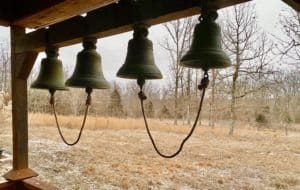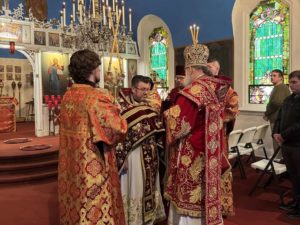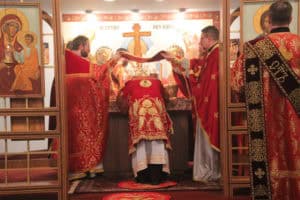NIANGUA, MO [DOM Communications] – The Diocese of the Midwest has recently opened its only monastery, Holy Resurrection Monastery, in Niangua, Missouri. The Department of Communications conducted an interview with the Abbas of the monastery, Mother Alexandra.
This interview serves as a brief introduction to the newly formed community and provides valuable information as to how one can support the monastery and stay informed on updates.
Mother Alexandra, it is a pleasure to speak with you about the new monastery that has recently been (re)established in the diocese. Can you share with our audience a bit of the monastery’s history and how it came to be?
 Thank you, Father Alexander. I am glad to have the opportunity to speak with you. His Eminence Archbishop PAUL blessed the (re)establishment and new name of Holy Resurrection Monastery on November 1, 2020. Having our Risen Lord as patron is a firm foundation to revitalize the monastic witness in our Diocese. In 1998, the monastery was first established, and in 2017, the monastics (there were two of them) decided to move to another monastery. I remember both in prayer here: one lives now in another monastery and the other has fallen asleep in the Lord. They accomplished so much, especially the construction and adornment of a beautiful chapel. The residence was vacant for a while, in the care of one of our parishes, and then occupied by caretakers. Almost a year ago, at the beginning of the covid-19 pandemic, I returned from missionary work in Guatemala to the United States and to the Diocese of Chicago and the Midwest, my original home. At that time, I was unaware that His Eminence desired to (re)establish this holy monastery. We began to discuss the possibility and to pray about it. He then invited me to visit the site. I was struck by the beauty of the chapel and the desire of the faithful to have a monastery and monastics in their midst. God’s plans are amazing, and when these are revealed to us, we must respond with our whole heart.
Thank you, Father Alexander. I am glad to have the opportunity to speak with you. His Eminence Archbishop PAUL blessed the (re)establishment and new name of Holy Resurrection Monastery on November 1, 2020. Having our Risen Lord as patron is a firm foundation to revitalize the monastic witness in our Diocese. In 1998, the monastery was first established, and in 2017, the monastics (there were two of them) decided to move to another monastery. I remember both in prayer here: one lives now in another monastery and the other has fallen asleep in the Lord. They accomplished so much, especially the construction and adornment of a beautiful chapel. The residence was vacant for a while, in the care of one of our parishes, and then occupied by caretakers. Almost a year ago, at the beginning of the covid-19 pandemic, I returned from missionary work in Guatemala to the United States and to the Diocese of Chicago and the Midwest, my original home. At that time, I was unaware that His Eminence desired to (re)establish this holy monastery. We began to discuss the possibility and to pray about it. He then invited me to visit the site. I was struck by the beauty of the chapel and the desire of the faithful to have a monastery and monastics in their midst. God’s plans are amazing, and when these are revealed to us, we must respond with our whole heart.
For those who may be new to understanding monastic life, what is the significance of having a monastery within diocesan territory?
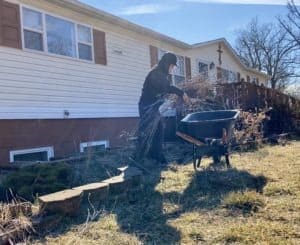 From a historical perspective, many of our great saints were monastics. They began as ordinary, faithful people who desired more. This provides courage for all of us. Saint John of the Ladder wrote that the reason a person remains in the monastic life is different from the reason they first came. I mention this because it is at the root of the significance of having a monastery within the diocese. Because of their necessary interactions, our faithful are surrounded by and at times enmeshed in this corrupt world that ensnares us. They come with a desire to remove themselves from that and to seek a haven of prayer and peace. This is wonderful, but what our Lord has in store is always dynamically more, and that is for each person to discover. The reason they return to the monastery may be different from their first visit. No one can predict what that will be.
From a historical perspective, many of our great saints were monastics. They began as ordinary, faithful people who desired more. This provides courage for all of us. Saint John of the Ladder wrote that the reason a person remains in the monastic life is different from the reason they first came. I mention this because it is at the root of the significance of having a monastery within the diocese. Because of their necessary interactions, our faithful are surrounded by and at times enmeshed in this corrupt world that ensnares us. They come with a desire to remove themselves from that and to seek a haven of prayer and peace. This is wonderful, but what our Lord has in store is always dynamically more, and that is for each person to discover. The reason they return to the monastery may be different from their first visit. No one can predict what that will be.
Our Lord explains in the Gospel of St John that we are in the world but not of the world; then He prays that we may be consecrated in truth. Monasteries are holy places where we can immerse ourselves in prayer and in all that has been resurrected to the Glory of God. This occurs not from us but from the Life-Giving Spring of the Holy Sacraments and the entire life of the Church that permeates every place, word and action in the monastery. Here is one example: often people struggle with their work or busy life at home because there seems to be a dichotomy between times of prayer and times of work. This is because the consequence of the Fall in Paradise is: “in toil you shall eat your bread.” Through prayer, monastics strive to overcome that dichotomy. By aspiring to pray at all times, work is transfigured into obedience, humility, prayer, and hopefully, faith, love, hope, and a holy, paradisiacal joy. These are the vital signs of the Church’s spiritual life.
 Moreover, while the faithful are making their way through their own wilderness with all the uncertainties, struggles, stress, and hurry of daily life, in every moment they can count on the asceticism and prayers at the monastery. Monastics, removed from the hustle and bustle of the world, immersed now in the discipline of a monastic schedule that is training them in true freedom, stand before the Tree of Life, the Cross, all day, every day. We wear a reminder of this on our habits, but we are reminded of it also by engaging our mind and body in the battles of the spiritual warfare, and in the constant redirecting of our spirit toward God. In other words, our focus is on the inner struggle, and the words of the LORD, “Do this in remembrance of Me” take on new meaning and life.
Moreover, while the faithful are making their way through their own wilderness with all the uncertainties, struggles, stress, and hurry of daily life, in every moment they can count on the asceticism and prayers at the monastery. Monastics, removed from the hustle and bustle of the world, immersed now in the discipline of a monastic schedule that is training them in true freedom, stand before the Tree of Life, the Cross, all day, every day. We wear a reminder of this on our habits, but we are reminded of it also by engaging our mind and body in the battles of the spiritual warfare, and in the constant redirecting of our spirit toward God. In other words, our focus is on the inner struggle, and the words of the LORD, “Do this in remembrance of Me” take on new meaning and life.
It is commonly known that prayer is the center of every monastery, but what are some other ministries that are unique to your monastery or ways in which the monastery supports itself?
The short answer is retreats and spiritual food. At this time, the Faithful may come for the day, spend time in the Chapel, enjoy the grounds, or help out as they are able to and as they desire. God willing, soon the monastery will be able to offer overnight hospitality for anyone wishing to spend some time in retreat. Currently, the rooms are being restored; hopefully they will be furnished. We also want to be able to offer a room to a person desiring to spend the day. Discussions are already underway to have overnight youth retreats and activities at the monastery. God willing, what a joy that will be! With the collaboration of parish clergy, there are endless possibilities. I also welcome invitations to worship with and visit the clergy and faithful in our parishes.
Chapel, enjoy the grounds, or help out as they are able to and as they desire. God willing, soon the monastery will be able to offer overnight hospitality for anyone wishing to spend some time in retreat. Currently, the rooms are being restored; hopefully they will be furnished. We also want to be able to offer a room to a person desiring to spend the day. Discussions are already underway to have overnight youth retreats and activities at the monastery. God willing, what a joy that will be! With the collaboration of parish clergy, there are endless possibilities. I also welcome invitations to worship with and visit the clergy and faithful in our parishes.
Additionally, the monastery has continued making liturgical candles. Being able prayerfully to dip and produce such beautiful 100% beeswax candles for prayer in Orthodox Churches is a blessing. It is another way the monastery can be connected to the spiritual life of our parishes. Mother learned the process from faithful of our diocese who continue to come to the monastery, and who enjoy working prayerfully in the candle shop.
Supporting our monasteries is important! Can you share with us how our parishes might be able to start ordering candles from you?
Yes, we are gladly receiving orders. Currently, parishes may call 417-943-2070 or send an email to nuns@holyresurrectionmonastery.org. The candles are 12” tapers, sold by the pound at $10.50 per pound plus shipping. (There are approximately 32 candles in a pound.) An online store is in the works and soon will be available, but calls and emails will always be welcome. Thank you in advance for supporting the monastery!
Finally, what is the best way for people to find information about the monastery and ways to support your efforts?
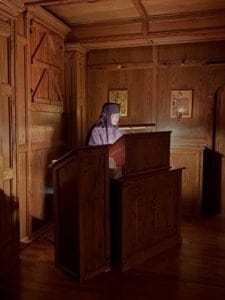 Holy Resurrection Monastery recently launched a new website at holyresurrectiomonastery.org. The site includes information about the monastery, the liturgical schedule, location, contact resources, the first publication of a tri-annual journal with an email signup form for future issues, a prayer list submission form, and secure donation portal. Additional pages are being prepared. They include: information about monasticism and monastic life at Holy Resurrection Monastery, an online gift shop, news, and a resource page.
Holy Resurrection Monastery recently launched a new website at holyresurrectiomonastery.org. The site includes information about the monastery, the liturgical schedule, location, contact resources, the first publication of a tri-annual journal with an email signup form for future issues, a prayer list submission form, and secure donation portal. Additional pages are being prepared. They include: information about monasticism and monastic life at Holy Resurrection Monastery, an online gift shop, news, and a resource page.
![]()
Thank you all for your prayers. Nothing happens without them! Thank you to His Eminence Archbishop PAUL and to the faithful of the Diocese of Chicago and the Midwest for their support, to all who offered their time and energy for the initial cleanup of the residence and grounds, to the donors of the mortgage payoff, a vehicle, a mower, a mixer for prosfora, food and other necessities, assistance with the website, and so much more. Moving forward, there is a mountain to tackle, especially to restore and furnish the monastic cells and guest rooms, repair the front and back stairs, repair the water leak, power wash the exterior of the residence and chapel, repair gutters and direct water from downspouts, paint the chapel entry way, furnish the chapel with two large matching rugs, clean and cultivate the grounds, etc. In addition, we need to provide health insurance for monastics. Anyone desiring to offer their support or to help out at the monastery, please contact Mother Alexandra to discuss particulars or skills that you would like to offer. Women who are interested in monastic life, continue to pray for this spark within and do not hesitate to reach out to Mother Alexandra.
Again, thank you Fr Alexander for your time in preparing and conducting this interview, but especially for your prayers, attention and support of the growth of Holy Resurrection Monastery. May it continue to be blessed!

